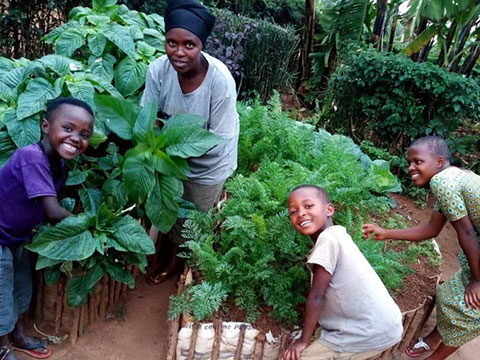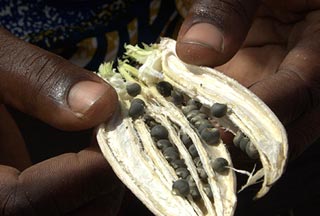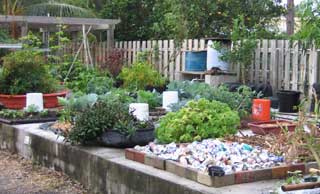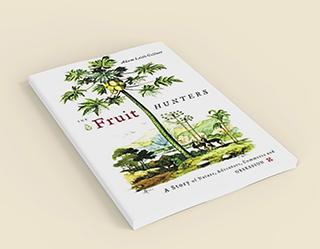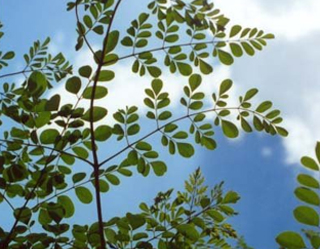Basket Vine, Trichostigma octandrum, a.k.a. Haitian basket vine, hoop vine, liann panye (in Haiti) grows as a large perennial, sprawling bush. It is considered a native species in South Florida and on many of the Caribbean islands. It has long pliable stems that are used in making baskets. The young leaves, eaten after cooking, are an outstanding green vegetable. They are reported to be extremely nutritious. Discard the cooking water. Some boil the leaves a second time in fresh water to remove traces of bitterness. (Note that the opposite of sour is bitter, so some vinegar or vinegar-based salad dressing might make it a better match for the taste buds of some.) There have been a few times where it has been killed to the ground in a freeze at ECHO, but will grow back. Although basket vine has a beautiful purple flower, it is propagated principally by cuttings.
“There have been a few times where it [basket vine] has been killed to the ground in a freeze at ECHO, but will grow back. ”

Cassava, Manihot esculenta
Cassava (a.k.a. Tapioca, yucca, manioc), Manihot esculenta, is an important root crop that is grown as a staple food in many parts of the tropical and subtropical world. Tapioca is made from processed cassava tubers. Cassava is tolerant of drought and poor soil, but needs good drainage. It is a perennial shrub harvested for its roots about 8-12 months after planting. Our cultivated varieties grow to about 8 ft. and tend to sprawl. The young, fully expanded leaves can be eaten after boiling. They contain 11-39% protein on a dry weight basis. Cassava is propagated by stem cuttings
Both the leaves and roots contain a cyanide compound, so both should be cooked and the water drained. Cassava should only be eaten in moderation. This reduces cyanide to a very low level. Check the web or ask a friend from the tropics for more details. Only eat cassava that is known to have more moderate amounts of cyanide. Cassava is frost sensitive but can re-sprout from the underground part of the stem if a freeze kills it to the ground. Keep in mind that your liver can detoxify modest amounts of cyanide and has almost certainly done that for you. Compounds that turn into cyanide when exposed to acid or chewed by an insect are one of the common ways nature has of helping plants survive. Plant available at ECHO Nursery
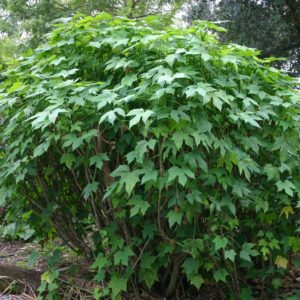
Chaya, Cnidoscolus aconitifolius
Chaya, Cnidoscolus aconitifolius, is sometimes called “tree spinach.” Its large leaves are boiled and eaten, especially in Mexico. It is also used to wrap tamales. The plant becomes a shrub about the height of a person and is quite attractive. Occasional pruning will make a more compact, bushy plant. Only if left unattended for a few years will it even resemble a tree here in Florida. The stems break so easily that you can easily prune them
As with its cousin, cassava, the leaves of chaya must be cooked around 10 minutes or more in boiling water or cooked as a stir fry or baked in a casserole to remove the small amount of cyanide they contain. Do not use them fresh in salads. The texture of the chaya leaf is firmer than many cooked greens. They remind me of collard greens. Most varieties of chaya have small stinging hairs that are harmless after cooking, but the variety ECHO sells is free of these hairs. A USDA study in Puerto Rico reported that one can get higher yields of greens per unit area with chaya than any other vegetable they have studied.
Chaya is unique in that it is exceptionally resistant to the hot humid weather of a Florida summer and to extreme dry weather (that is the climate in Central America where the plant is native). Insects have not bothered chaya at ECHO. If the plant blows over in a tropical storm or the above-ground part is killed by a freeze, don’t worry. This often makes for a prettier, more unique plant, as the main stem sends up additional branches and a bushier plant results. Chaya plants almost never produce seeds, but propagate easily by cuttings. Plant available at ECHO Nursery
Katuk, Sauropus androgynus, (a.k.a. sweet leaf) is one of the staple vegetables in the rainforest climate of Borneo. It has become one of the favorite salad greens of the staff at ECHO, and is eaten either cooked or fresh for its nutritious leaves and shoots. The unique flavor of these leaves is most similar to raw peas when eaten raw. It grows exceptionally well in Florida, going dormant in the winter.
Katuk is disease and pest resistant, tolerates most soils, and grows in sun or shade. For the best tender shoots and leaves, grow katuk in at least half shade and fertilize frequently. This shrub should be occasionally pruned to 3-5 feet since it tends to grow straight up until it falls over. In SW Florida it can be killed back by hard freeze but grows back from the ground and may re-grow bushier than before. In Asia, katuk is propagated by seed as well as cuttings, but in SW Florida we have not been very successful with seed propagation. Plant available at ECHO Nursery
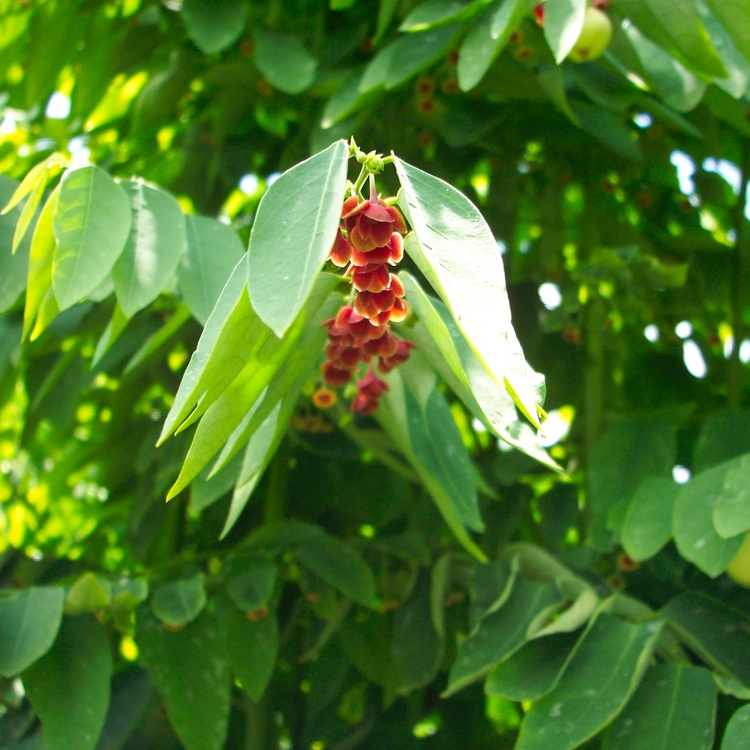
Katuk, Sauropus androgynus
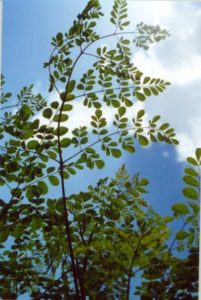
Moringa, Moringa oleifera
Moringa, Moringa oleifera, (a.k.a. horseradish tree) is a tree grown for food and seed at ECHO. It is one of the most requested seeds in ECHO’s seed bank. This is due to its many edible parts and its ability to survive in arid parts of the world. It is an exceptionally nutritious leafy vegetable. The large frilly leaves can be broken off easily at the stem and carried inside. The tiny leaflets can then be quickly pulled off between the fingers. Tender growing tips can be cooked stem and all. At ECHO, leaves are boiled as any green or added to soups or rice. In the southern portions of the United States the tree will probably survive a hard freeze but may be killed to the ground. Even where no freeze damage occurs, some people cut it back to about 4 feet each year. This causes the leaves to be closer to the ground for ease of harvesting. If not forced to branch by pruning, the tree becomes tall, spindly and in most cases not very attractive. We do not recommend it as a prominent shade tree or landscape specimen.
Moringa might have potential as an annual vegetable farther north. We are told that as far north as Gainesville Florida it is grown as a “cut and come again” perennial. We were sent a photo of a tree that was started in a greenhouse, transplanted out, and grew to the height of eight feet in Wisconsin before winter killed it. Aside from eating the leaves, very young pods can be cooked and eaten like asparagus or green beans. Pod production is variable and seems to be increased by stress. Some trees bloom at less than a year old and others take longer.
Along with the moringa leaves and pods, the blossoms are also edible. All parts have a taste similar to mild horseradish. When trees are about 3‑4 feet tall, they can be pulled out of the ground and the roots grated and used like horseradish. The root bark is toxic and should be peeled off before grating. Eat the roots in moderation only. Personally I just buy horseradish if that is the flavor I want and don’t risk the potentially harmful chemicals in the roots. Crushed raw leaves may irritate the skin and, if eaten in quantity, can be purgative. Under good conditions the tree can easily reach 15 feet the first year. The wood is very soft and does not make good fuel wood. Moringa may be propagated either by seed (available in ECHO’s bookstore) or cuttings. Trees from cuttings tend to be more susceptible to blowing over in the wind because the roots tend to be more shallow. Plant and seed available at ECHO Nursery
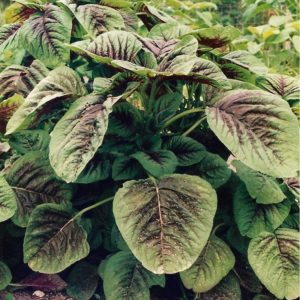
Amaranth (vegetable type), Amaranthus tricolor
Amaranth (vegetable type), Amaranthus tricolor (a.k.a. tampala) is attractive (especially the variety ‘tiger leaf’) and produces leaves that taste much like spinach when cooked. Though it will grow well in the summer, stay alert to the likely arrival of small caterpillars that can devastate it within a few days. The natural insecticide called B.t.® or Dipel ® can be bought at your garden center and will control the insect if used in time. Vegetable amaranth or tampala is an annual and is propagated by seed. Seed available at ECHO Nursery
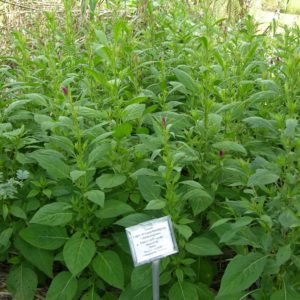
Lagos spinach, Celosia argentea
Lagos spinach, Celosia argentea (a.k.a. quail grass), is a cousin to vegetable amaranth but much less prone to insect damage. It is quite popular in SE Asia as well as West Africa where it originates (presumably named for Lagos, Nigeria). As a young plant before it flowers, it makes a tasty cooked green. Harvest it when it reaches 8-12 inches in height (before it flowers), cut up the whole plant except for the roots and put it into the pot. Boil it for at least a minute or two and discard the dark water. It is very much like cooked spinach in taste, color and texture.
We found out the hard way not to steam cook it because boiling in water is needed to remove oxalates that otherwise leave a burning sensation on the tongue. It also has a beautiful flower later in the year; though at that stage the leaves become narrow and are not useful in cooking. Lagos spinach is an annual and is propagated by seed. There is a red- and a green-leafed variety. Seed available at ECHO Nursery
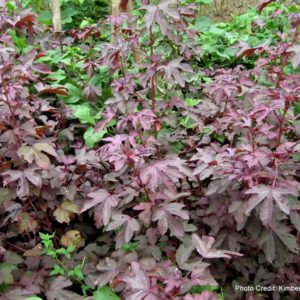
Cranberry Hibiscus, Hibiscus acetosella,
Cranberry Hibiscus, Hibiscus acetosella, a.k.a. false roselle or red-leaf hibiscus has striking red leaves and is similar to Japanese maple, in both leaf shape and color. It can be planted in the spring and kept pruned for an attractive annual shrub and may be grown as a temporary hedge. Cranberry hibiscus is nematode and insect resistant and does well in sandy soil.
The young tender red leaves have a tart flavor and are an attractive addition to fruit and tossed salads, slaws, or stir fries. In the fall it has pink blossoms. About thirty blossoms can be picked at dusk after they have folded, and blended with lime juice and sugar to make a beautiful and tasty drink. The petals add a bright red color rather than any special flavor. Pinch the tips of stems as it grows to make it bushy, otherwise it will grow several feet tall and fall over. Cranberry hibiscus may act as a long-term annual or as a short-term perennial and can be propagated by seed or by cuttings. Plant and seed available at ECHO Nursery
“The young tender red leaves [of cranberry hibiscus] have a tart flavor and are an attractive addition to fruit and tossed salads, slaws, or stir fries.”
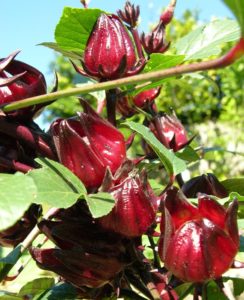
Roselle, Hibiscus sabdariffa i
Roselle, Hibiscus sabdariffa is sometimes called “Florida cranberry” because of the bright red, crunchy, sour calyx that can be used somewhat similarly to cranberries in recipes. The calyx surrounds the developing fruit and seed and is the size of a small nut. A very popular drink is made from the calyx in many tropical countries by cooking them in water, then adding sugar and lemon juice and cooling. Plant roselle later in the summer to avoid likely root knot nematode damage. It will not bloom and form the edible part until around October. Roselle, an annual is propagated by seed. Plant and seed available at ECHO Nursery
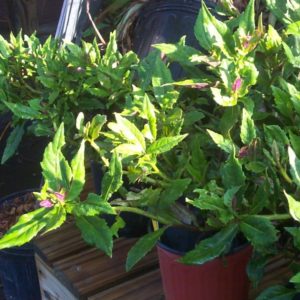
Okinawa Spinach, Gynura crepioides
Okinawa Spinach, Gynura crepioides forms a dense, non-vining, edible ground cover, or as a specimen plant that grows well in full sun or partial shade. Grown commercially in China, the plant is a vigorous, perennial vegetable that is adaptable to a variety of tropical climates and requires little if any additional input. Okinawa spinach has attractive pointed leaves that are green on the top side and purple underneath. Young leaves and shoots can be eaten raw or cooked. Its rather insignificant yellow blossoms attract a constant stream of butterflies. Okinawa spinach has potential to grow for more than one year but usually declines after about a year at ECHO. It is propagated by cuttings. Plant available at ECHO Nursery
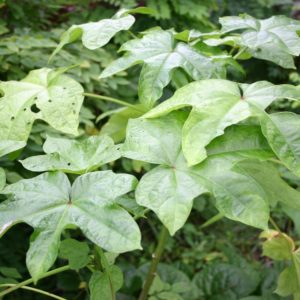
Edible hibiscus, Abelmoschus manihot
Edible hibiscus, Abelmoschus manihot, is a shrubby perennial from Indonesia, the leaves of which are flavorful eaten fresh as one would eat lettuce or cooked either alone or added to soups. It is grown exclusively for its leaves and is a very prolific producer, out yielding most crops planted for the production of leafy greens. It is touted as having very high nutritive value. Edible hibiscus must be propagated by cuttings, and is susceptible to nematodes. If you do not have nematode-free soil, try planting edible hibiscus in containers. The leaves can be as large as a slice of bread and one leaf can be used instead of lettuce. The plant is a hibiscus but only blooms, sparingly, in SW Florida around January. Plant available at ECHO Nursery
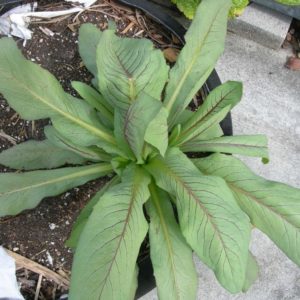
Tropical lettuce, Lactuca indica
Tropical lettuce, Lactuca indica, (a.k.a. Indian lettuce) grows well in full sun and tolerates the heat of the South Florida summer, growing to perhaps four feet tall. When eaten fresh, the leaves are somewhat bitter. Tropical lettuce has a nice flavor when stir-fried or boiled. Tropical lettuce can be propagated by cuttings and by seed. As this “tropical lettuce” is perennial, it can be cut back and it will re-sprout. When you do this, remember to fertilize it to give it the needed boost.
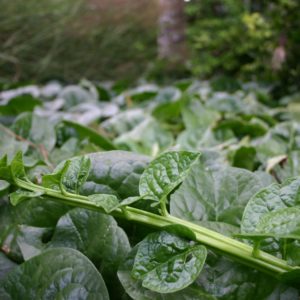
Malabar spinach, Basella alba
Malabar spinach, Basella alba, a.k.a. Basella or Ceylon spinach is grown for its attractive edible leaves that are cooked. Some people like the mucilaginous leaves and some do not. It has potential to be a great substitute for lettuce in our hot summers. The plant can grow up a fence or trellis or sprawl along the ground and, on top of mulch, forms an attractive ground cover. Malabar spinach is a perennial that comes in two stem colors. The variety ‘Bangladesh’ has red stems; the variety “green” is entirely green. Both are propagated by seed and by cuttings. Plant and seed available at ECHO Nursery
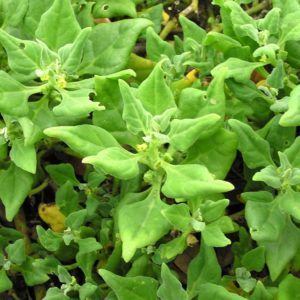
New Zealand spinach, Tetragonia tetragonioides
New Zealand spinach, Tetragonia tetragonioides is an annual green that often behaves more like a perennial. This is partially because the plant continues to grow and produce until the surrounding environment is no longer favorable for its growth and partially because it produces seeds close to the crown of the plant where they inconspicuously drop into the soil. They then lie dormant until conditions are ideal for them to germinate and continue growing the following season.
Soak the seeds overnight before sowing. Plant in pots or direct seed into the garden, spaced at 1-2 feet apart. New Zealand spinach likes fertile soil, so the addition of organic matter in the form of compost, worm castings or animal manures will help maintain its lush vegetative growth. Harvest by snipping 3-4 inch tips of the stems or individual leaves. Picking them at least once a week ensures continued lush growth and leaf production. They may be prepared as you would spinach – either by cooking (steamed, boiled, stir-fried) or by eating fresh in salads, and may substitute for spinach in any recipe. Plant and seed available at ECHO Nursery
